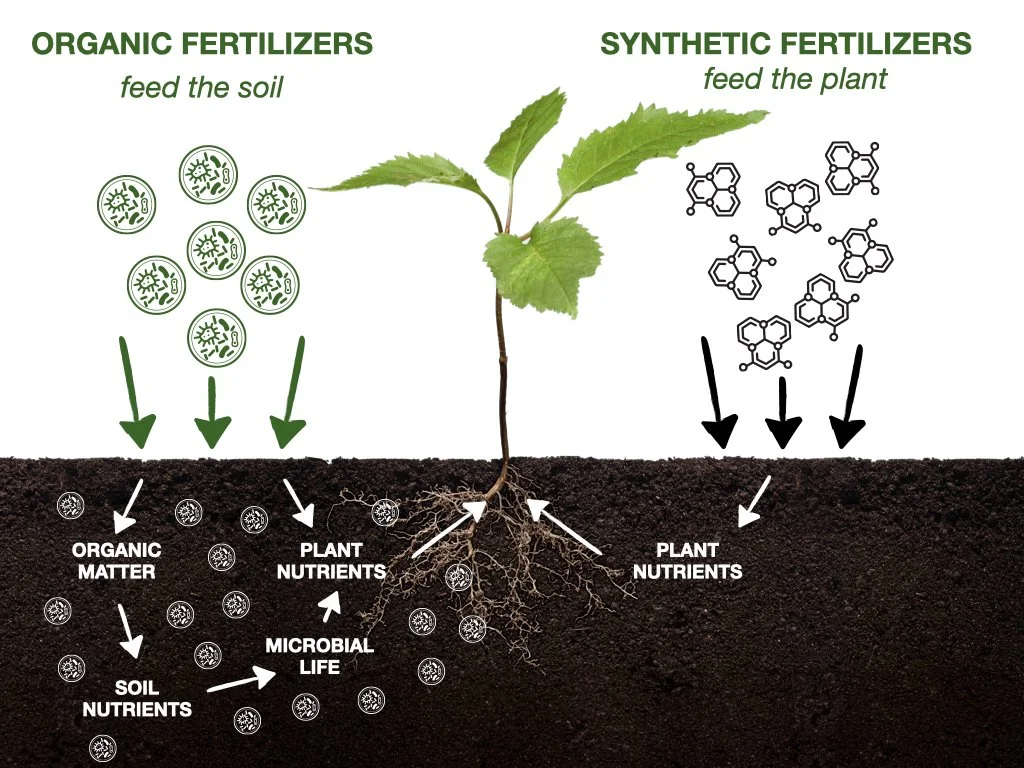
Working with Urth Agriculture.
We make HEALTHY SOIL easy.
We honor that every farm has unique protocols to guarantee production. We also recognize that any changes in your protocol create additional risk. That's why we don't ask you to change a thing.
Urth works within your existing system to customize a solution that creates less work and reduces costs. Unlike so many conventional agriculture products, ours have zero negative impact on the environment.
Working within your systems… and Nature’s.
Conventional or organic, flood or drip, pasture or Greenhouse... you have your own unique system for growing, and we work with you to integrate our products and approach into your systems—naturally.
Because by blending best practices from Nature’s playbook, with your existing practices, the results can be astounding.
Healthy soil begins with SOM.
Building SOM has never been easier & more important.
Soil Organic Matter (SOM) is critical in soil health, crop production, and overall agricultural sustainability. Urth Agriculture’s proprietary SOM Protocol drives nutrient availbility & retention within the soil - leading to improved harvests, less watering, and the stabilization of Nitrogen.
With no additional labor costs or changes to your systems and protocols, Urth works within your infrastructure to design custom application programs that will show significant increases in SOM and, consequently, more profitable harvests year-after-year.
HEALTHY SOIL
SOM serves as a reservoir of essential nutrients such as nitrogen, phosphorus, potassium, sulfur, and micronutrients. As organic matter decomposes, these nutrients are released into the soil solution in forms that plants can readily absorb. This slow and steady nutrient release reduces the risk of nutrient leaching and ensures a more sustained supply of nutrients to crops.
IMPROVED HARVESTS
Soils rich in SOM support healthier and more robust plant growth. The enhanced nutrient availability, improved water-holding capacity of the soil, and balanced pH contribute to better plant health and increased resistance to diseases and pests. Supporting SOM will show more abundant growth, higher bricks, and more resilient crops year-after-year
SUSTAINABILITY
SOM building is the future cornerstone of sustainable agriculture. SOM influences various soil properties and processes that are fundamental to plant growth and ecosystem health. The implementation of our SOM Protocol, promote the accumulation of SOM over time, leading to more resilient and productive agricultural systems, while also contributing to environmental conservation and climate change mitigation efforts.
The many, many benefits of building SOM.
SOM improves the soil's capacity to store and supply essential nutrients (such as nitrogen, phosphorus, potassium, calcium and magnesium), and to retain toxic elements. It allows the soil to cope with changes in soil acidity, and helps soil minerals to decompose faster. Learn about the breadth of benefits that come with high SOM content.
-
Soil organic matter serves as a reservoir of essential nutrients such as nitrogen, phosphorus, potassium, sulfur, and micronutrients. As organic matter decomposes, these nutrients are released into the soil solution in forms that plants can readily absorb. This slow and steady nutrient release reduces the risk of nutrient leaching and ensures a more sustained supply of nutrients to crops.
-
Organic matter enhances soil structure by binding soil particles into aggregates. These aggregates create pores and channels within the soil, improving water infiltration, drainage, and aeration. Good soil structure prevents compaction and erosion, making it easier for plant roots to penetrate the soil and access water and nutrients.
-
Organic matter helps the soil retain moisture by increasing its water-holding capacity. This is particularly beneficial during dry periods, as it allows plants to access water for a longer period of time. Additionally, improved soil structure helps prevent excessive runoff, reducing the risk of soil erosion and promoting efficient water use.
-
Soil organic matter is a vital food source for microorganisms, including bacteria, fungi, and other decomposers. These microorganisms break down organic materials, releasing nutrients in a form that plants can use. The microbial activity supported by organic matter contributes to nutrient cycling, promoting a healthier and more productive soil ecosystem.
-
Organic matter acts as a buffer against drastic changes in soil pH. It helps maintain a slightly acidic to neutral pH range, which is optimal for nutrient availability and uptake by plants. This buffering capacity is especially important in soils prone to pH fluctuations.
-
Soil organic matter is a significant reservoir of carbon in terrestrial ecosystems. Increasing soil organic carbon levels contributes to carbon sequestration, helping to mitigate the effects of climate change by reducing atmospheric carbon dioxide levels.
-
Soils rich in organic matter tend to support healthier and more robust plant growth. The enhanced nutrient availability, improved water-holding capacity, and balanced pH provided by SOM contribute to better plant health and increased resistance to diseases and pests.
-
Maintaining and building soil organic matter content can lead to improved soil fertility and long-term agricultural productivity. Continuous addition of organic matter through practices like cover cropping, crop residue incorporation, and compost application can lead to sustained high yields and reduced dependency on synthetic fertilizers.
How do I improve SOM and how much SOM is ideal?
The Urth SOM Protocol is by far the fastest way to increase SOM. Additional practices that increase SOM include increasing crop biomass production, retaining crop residues in the field, reducing or eliminating tillage and applying organic matter into the soil.
In most cases, the maximum expected change in SOM is less than 2 percentage points (for example, from 2 percent to 4 percent SOM or from 4 percent to 6 percent SOM). Larger changes in SOM are possible over time with repeated application
Measuring SOM.
Urth Agriculture’s SOM Protocol produces measurable increases in the % of SOM content within an impressively short period of time. Measurable improvements in SOM often take at least 3-5 years and growers should not be concerned if SOM changes are not immediate.
There is currently no laboratory test to directly quantify SOM. Estimation of SOM is usually accomplished through a measure of soil organic carbon (SOC), total soil carbon, or weight loss on ignition.
The importance of Microbial life.
BENEFITS OF FEEDING SOIL MICROBES FOR CROP PRODUCTION
GROWTH CYCLE
-Early plant emergence
Reduction in soil compaction
Increases root growth
Improves efficient soil nutrient uptake
Improves plant health
Increases air and water vertical movement
DORMANT CYCLE
Reduction of soil erosion
Improvement in water-holding capacity
MATURITY CYCLE
-Promotes higher yields
Improves nutrient density
Reduces root dehydration
Improves stalk strength
Increases resistance to predator insects
Increases drought and frost tolerance
DECOMPOSITION CYCLE
Increases organic decomposition
Improves soil structure
Improves soil tilth (aggregation)











